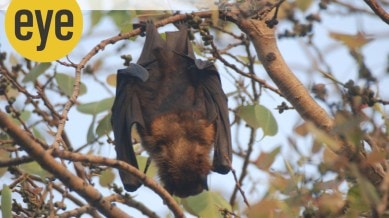Fruit bats: the Boeings and Airbuses of the animal kingdom
The only mammals that can maintain sustained flight, a fruit bat can give you the heebie-jeebies while flapping close past you

Way back in the late 1970s, I often used to stand out on the balcony of our fourth-floor flat in Bombay at dusk and wait for the squadron of fruit bats – aka flying foxes – hanging from a huge peepal tree growing in the garden. There would be some querulous chittering, then the bats hanging towards the top of the tree (like so many broken umbrellas) would take off, quickly followed by the others. It always reminded me of a squadron of World War II bombers setting off on a mission to reduce some enemy city to rubble and I wondered where they went. As far as I knew there were few big fruiting trees on the road I lived on – verdant Malabar Hill – so maybe that’s where they were headed. (I needn’t have worried – fruit bats fly more than 150 km for a decent dine-out!)
This year, during the monsoon, I was in Goa again and once more at dusk heard the same querulous chittering – sounding more ghoulish and quarrelsome than before – and attributed it to the big barn owl that had taken up temporary residence under an awning in an adjoining block. Barn owls have the reputation of scaring the bejesus out of people with their repertoire of screeches and shrieks. But then these huge leathery flapping creatures flew past the balcony time and again and I quickly realised that these were my old friends the fruit bats. This was the breeding season for them, hence the bad attitude and language! On a subsequent visit, during Diwali, they were flying around again, but silently, except when they crashed into the areca palm outside my bedroom window for a quick top-up of nectar from its flowers. They noisily crash landed and then in total silence, in a somewhat malevolent spidery manner made their way to the blooms, quickly drank and left, reminding me of a Formula 1 pit stop! I have still to discover where they roost during the day – there are a lot of tall trees around which could provide them roosts.
monthly limit of free stories.
with an Express account.
Close up, what takes you by surprise is how big they are. Their wingspans may stretch to 1.5 m and they may weigh 1.6 kg. Their smooth leathery wings are attached to the sides of their bodies and their ‘arms’. They along with all others of their clan – big and small – are the only mammals that can maintain sustained flight. There are 13 varieties of fruit bats in India, and I couldn’t tell exactly which they were (it was dark!). But they can be black, brown, grey and with yellowish bellies, and most have faces which only their mothers can love.
Fruit bats are nocturnal and will spend the day hanging upside down from tall trees, rustling restlessly from time to time. As if feeling cold (imaginary!) they will wrap their wings around their bodies like cloaks and doze. Like most of us, they are especially fond of mangoes and bananas and so unpopular with orchard growers of these trees, which they will raid at night. But they will tuck into as many as 300 varieties of ripe fruit and spread their seeds far and wide, as well drink deeply of nectar from flowering plants. This was one reason they were considered to be vermin but have now been given a modicum of protection under the Wildlife Protection Act 1972, under Schedule II. Their populations are said to be declining – with outright hunting and habitat destruction being the major causes. It has been found that as much as 70 per cent of bat guano contains the seeds of the banyan tree – a keystone species, commonly called the kalpavriksh, without which few tropical jungles could survive.
If it weren’t for fruit bats we probably could kiss goodbye to mangoes and bananas and a host of other fruit, which they pollinate so they are pretty important cogs in the ecological ecosystem. While mama bat does look after her baby well, both parents are outrageously adulterous and have no qualms about it. They have extremely scandalous sex lives which would upset the sentiments of many, so perhaps it’s better that you check this out yourself if so inclined!
Easily the most serious criminal charge levied against fruit bats is that they (along with most other bats) are carriers of several very unpleasant and dangerous viruses: rabies, Nipah, Zika, dengue, yellow fever and suchlike. This has caused entire colonies of bats to be destroyed in areas where these diseases occur. In reality, there is not much to fear for us catching these diseases from the bats, unless we get up too close and personal with them. In the case of the Nipah virus, it is thought that it might spread from bats to humans via the sap of the date palm, which is tapped in small conical containers tied to the trees, which the bats may take a sip or two of before we harvest them.
Unlike others of their kind, they do not use echolocation to find their prey – really they don’t have to, mangoes and bananas can’t fly away – and instead rely on their excellent night vision. And really, their dark glowing eyes are perhaps their most attractive feature on their screwed up, mouse-like faces!
While flapping close past you they can for sure give you the heebie-jeebies but remember these are the only mammals capable of sustained flight over long distances and so deserve a great deal of respect! We need Boeings and Airbuses!